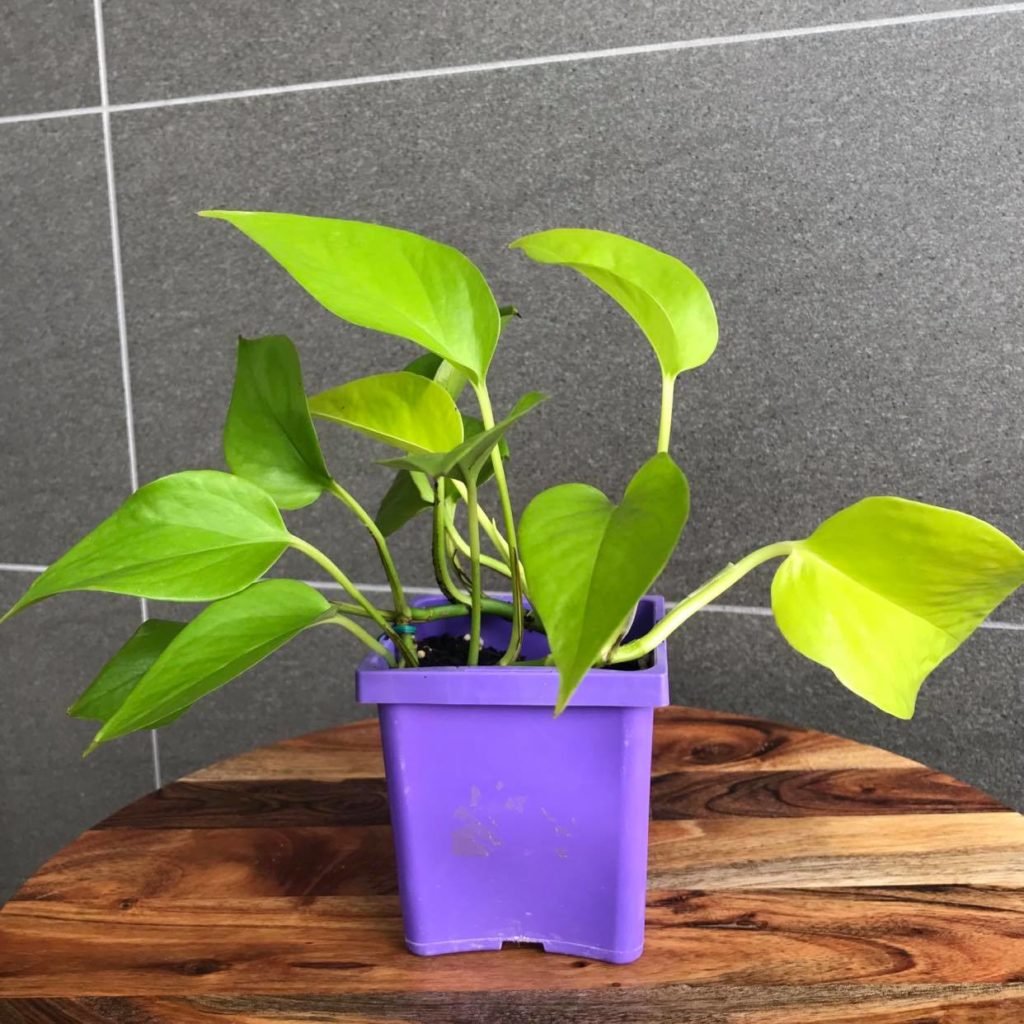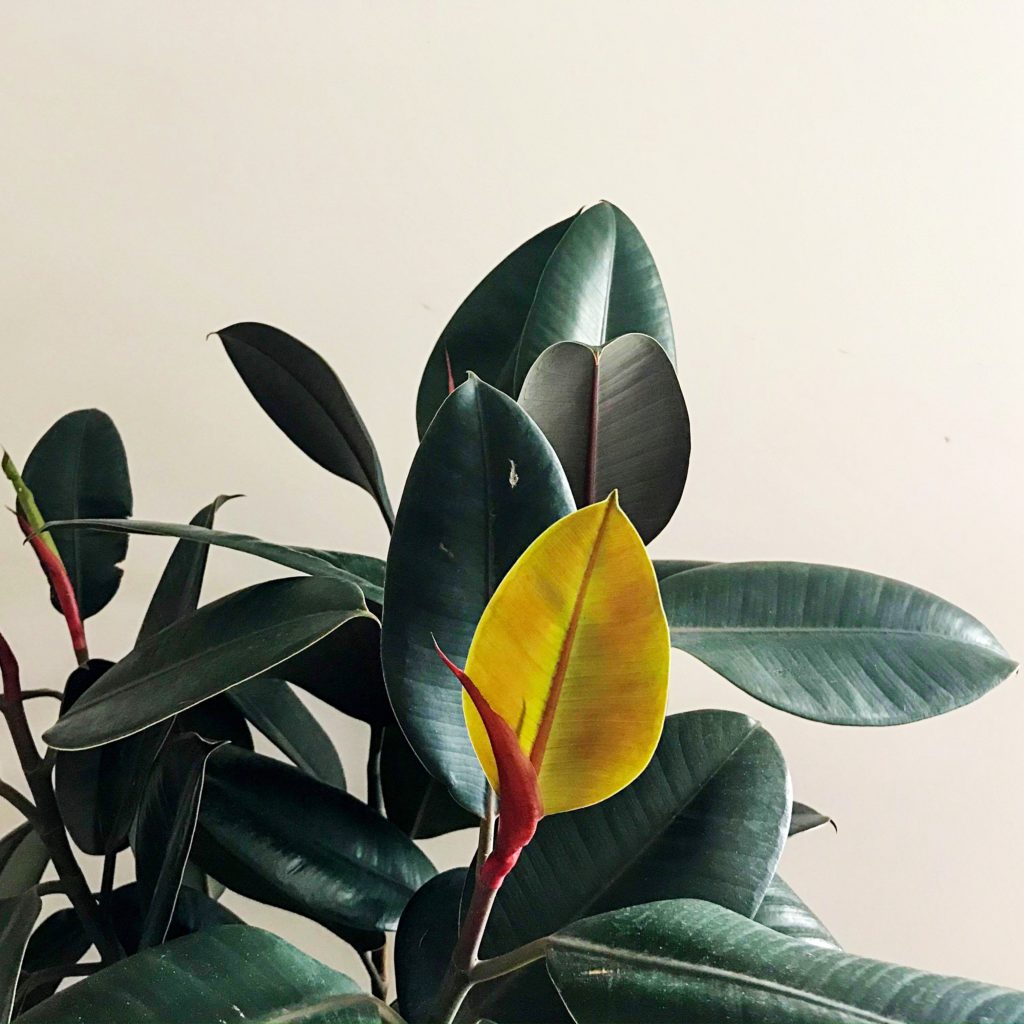Epipremnum Aureum ‘Neon’ a.k.a Neon Pothos
Neon Pothos are a much beloved houseplant of the Araceae family, native to the Solomon Islands. This beautiful vining plant climbs the trunks of larger trees whilst producing an abundance of bright neon green foliage and aerial roots. In this guide we will go through everything you need to know to care for Neon Pothos.
Since this type of plant loves to climb, it will grow best when given a pole or trellis to climb up. However, this plant will also look amazing and thrive in a hanging basket. Not only does this plant look good but is super easy to care for and easy to propagate! Making it a perfect plant for beginners.

Neon Pothos Quick Overview
| Full Size | 6-10 feet |
| Light | Bright indirect |
| Temperature | 65-90°F (18-32˚C) |
| Humidity | Medium to high |
| Cost | $ |
| Care Level | Easy |
| Toxicity | Toxic |
Size
The mature size of a Neon Pothos can be up to 30 feet long. When kept indoors, you can expect your plant to reach up to 6-10 feet in length and 3 feet in width. Adding a pole for the plant to climb will help support it as well as encourage larger leaves.
Neon Pothos are known to grow and produce foliage fast when kept in the right conditions. Slow growth can be caused by inadequate lighting, as this plays a major role in plant growth. Colder temperatures can also stunt growth as they will enter a state of dormancy.
Light Requirements
Neon Pothos will grow best when in bright indirect lighting. However, this plant can tolerate low light conditions. A sign that your Neon Pothos isn’t receiving enough light is if the foliage is growing smaller and turning pale green in colour. Moving your plant to a brighter spot will help keep it happy and healthy.
The foliage of your Neon Pothos can burn when exposed to direct sunlight. Adding a blind or curtain to your window will help to defuse the harsh sunlight to avoid burning the plants foliage. Alternatively, if you can’t seem to find that perfect spot in your home, you can always use grow lights.
Just like direct sunlight, if your plant is sitting too close to the grow lights, they will burn the foliage. Keeping a safe distance of at least 60cm between your plant and the light will avoid any trouble.
Temperature
The ideal temperature for growing Neon Pothos is between 65 to 90˚F (18 to 32˚C). This plant loves warm climates and won’t tolerate cold conditions. If the temperate drops below 55ºF (12ºC), your Neon Pothos can have stunted growth and foliage may turn black. During the cooler months, you should move your plant to a warmer spot in your home.
Humidity
Neon Pothos will thrive when kept in an average-high (above 50%) humidity environment. This plant can tolerate lower humidity levels however, higher humidity helps to promote healthy growth. Brown leaf tips can be a sign that the air is too dry. Neon Pothos love greenhouses as this helps better mimic the conditions of the sub-tropical island to which it is native to. For more information on growing Neon Pothos in greenhouses check out here.
Providing a high humidity for your plants will encourage bigger and healthier growth. There are a few thing you can do that can help bump up the humidity in your home. The things you can try are:
- Misting your plants
- Pebble trays
- Grouping plants together
- Humidifier
If you are struggling with humidity levels make sure to see our tips for indoor plant humidity.
Watering Requirements
Neon Pothos like to be moderately watered. This plant likes a moist soil. Before watering, you should check the top 1-2 inches of soil with your finger to feel if it’s still moist. If the soil is dry, you can give your plant a drink. This plant can tolerate a dry soil so you don’t need to worry if you miss a watering. Wilting and/or curling leaves can be a sign that your Neon Pothos needs watering.
Although Neon Pothos like a moist soil, you should be cautious of over-watering. Excess water to the soil can cause it to become waterlogged and start rotting the roots. This can cause fungus issues, pest problems and root-rot. Signs that you may have over-watered your Neon Pothos are wilted and yellowing/browning leaves.
Fertilizing requirements
You should fertilise your Neon Pothos monthly during Spring and Summer. There’s no need to fertiliser during the cooler months (Autumn and Winter) when growth slows. We have found best results stopping fertilizing mid-late Autumn and continuing again early spring.
Applying fertiliser while your plants aren’t actively using up the nutrients in the soil can cause salt build up and root burn. Fertilising your plants helps give them the essential nutrients they need for promoting and maintaining new and healthy growth.
The best fertiliser to use for Neon Pothos would be a balanced all purpose fertiliser diluted to half strength. Depending on what you prefer, you can use a slow release fertiliser instead of a liquid.
You won’t need to fertilise as often if you prefer using a slow release fertiliser. A sign that your Neon Pothos might need fertilising is if you notice discolouration of the foliage and stunted growth.
Another thing you need to look out for when fertilizing your house plants is over-fertilizing. Over-fertilizing your Neon Pothos can burn the roots and foliage. If you think you’ve over-fertilized your plant you can either change the soil or rinse the fertilizer out of the soil. You will notice a change in the water colour once the fertilizer has been rinsed out.
For more information checkout our guide to fertilizing house plants.
Soil Requirements
Neon Pothos like to be in a well draining soil. To achieve a well draining soil, you can add orchid bark, peat moss and perlite to a general potting soil to help create better aeration and drainage. Air flow is important is potting soil as it allows the plants roots to breath. Not having enough oxygen to the roots can cause them to start rotting.
You can also add other organic materials like coco coir, mulch chunks and coconut husk to help restrain moisture. Neon Pothos like to be kept in a moist soil so it’s important to use ingredients that will help hold onto moisture but not cause the soil to become soggy. Adding garden compost can also help to add more richness to the soil.
Diseases & Pests
The most common pests that you may encounter on your Neon Pothos are Mealybugs, Spider Mites, Thrips and Scale. The most common diseases you may encounter are Root-rot and leaf spot. For more information on identifying and treating common houseplant pests click here.
The best thing you can do when it comes to pests on houseplants is to try and avoid any pest infestations from starting. There are a few things you can do that will assist in preventing any pest infestations and these things are:
- Checking new plants for pests or isolating new plants for up to a week.
- Check your plants every few days for pests.
- Trim off any dead or dying leaves.
- Wipe down leaves if you notice them getting dusty.
- Keeping your plants healthy. A healthy plant will be able to handle an infestation better than those that aren’t as happy.
- Isolate any plants that have pests.
Following this will assist in keeping pests away as well as catch them early on before any severe infestations are able to start. Keeping plants healthy and in the correct living environments can help to deter any pests from invading your plants.
Toxicity
Neon Pothos are considered to be toxic to humans and pets if ingested. Common symptoms can include burning sensation in the mouth, skin irritation, swollen tongue and vomiting. If ingested by pets, the symptoms may include drooling, pawing at the mouth and irritation of the mouth, eyes, lips and tongue.



